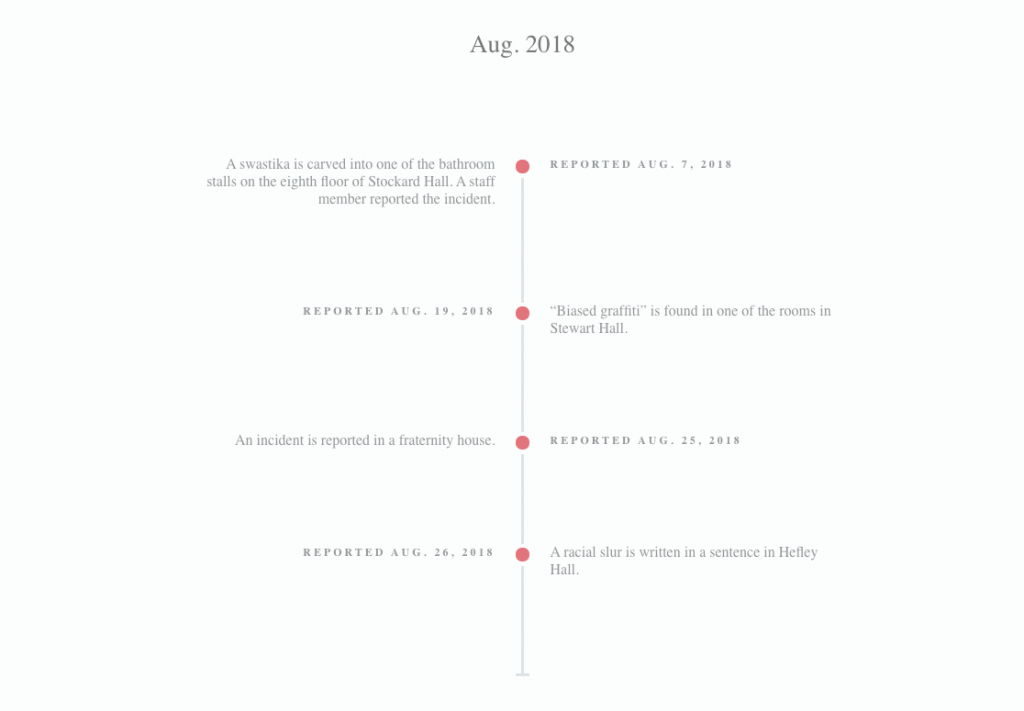To see a full timeline of all bias incident reports, click here.
To see an update on how BIRT is changing, click here.
Homophobic slurs yelled at students, racist vandalism across campus, white power symbols displayed in photos and a professor telling a student to drop out of school because of a medical condition are some of the 26 incidents of bias that were reported to the university during the 2018-19 school year.
The details of the incidents — sent to the Bias Incidents Response Team (BIRT), which receives and responds to reports of bias at the university — were obtained by The Daily Mississippian in a public records request. On average, a report was filed every eight days during the fall and spring semesters.
The reports offer a look into the interactions that make some feel unwelcome or unsafe on campus, from swastikas being carved in bathroom stalls to drinks being thrown at students while homophobic slurs are shouted at them.
In one instance, a fraternity displays a group photo in which someone is expressing a white power sign in their right hand. A few days after that report was sent to BIRT, another was sent reporting a white power sign being displayed in a class photo.
In another report, a professor tells a student that she should drop out of classes and come back later in life to finish her degree because of the student’s health problems.
One student reported experiencing multiple incidents of bias in the first weeks of the semester. The student reported being profiled by residence life front desk staff and by the University Police Department (UPD) after being pulled over for not using his headlights. The K-9 unit searched the vehicle and several backup officers came to the scene, according to the report. UPD did not respond to requests for comment.
Among the reports is the incident of three members of the university community posing with guns for a photo in front of a bullet-riddled Emmett Till memorial. The incident was reported to BIRT on March 7, and the Mississippi Center for Investigative Reporting (MCIR) reported on the incident on July 25. After this incident was publicly reported, a process to make changes to BIRT began.
The number of BIRT reports has increased since the 2013-14 academic year, during which 16 incidents were reported. Reports peaked during the 2016-17 year with 35 incidents. BIRT reports do not account for reports made only to other entities on campus, such as UPD or Equal Opportunity & Regulatory Compliance.
“More (reports) is not always a bad thing,” Katrina Caldwell, vice chancellor for diversity and community engagement, said.
She said that more reports often mean that people feel more comfortable using the resources for them on campus. She also said that in her time at the university, there have not been any reports that were not supported by evidence upon investigation.
“I think raising awareness gives us an opportunity to address it, and so I want to make it clear that more (reports) is not an indication that there’s more bias in our community,” she said. “We’re not capturing all of the bias in our community.”
BIRT receives reports of bias on campus, works to educate groups and shares the information with other university entities, like the University Police Department, Judicial Conduct, Equal Opportunity and Regulatory Compliance and the vice chancellor for diversity and community engagement.
“BIRT doesn’t punish,” Caldwell said. “(Education) is its only function.”
Caldwell also said that BIRT handles reports individually, working to tailor educational opportunities to the situation and group addressed. If there is a report in a fraternity house, residence hall or academic department, those groups might be offered education tailored to the incident and group affected. Education may or may not be voluntary, depending on the situation.
Other entities on campus may choose other responses, depending on their institutional roles.
BIRT also focuses on supporting people who are affected by bias, whether by listening or by offering services, like counseling.
The group is made up of 17 people, with 13 faculty and staff members and four students.
Caldwell said that whenever groups are together — in person or online — bias is more likely to occur and have more of an effect on the community.
Of the 26 reports, many occurred in residence halls, fraternity houses and sorority houses.
Traditions play a role in continuing bias on campus, Caldwell said, adding that some who partake in those traditions do not understand the magnitude of what they’re doing.
“When I asked (about an incident), for a number of groups when they are brought in or we have a conversation about a particular action, I’m invariably told (they) didn’t know that that was offensive, and so I think that some folks are passing down traditions that they don’t know are racist, sexist, homophobic, transphobic,” she said.
Still, others do know what they are doing, she said.
“I don’t think their membership in any organization is necessarily an indication that they have more of a proclivity to do it,” she said. “But there are people in our community who know what they’re doing, and they’re intending to make people feel uncomfortable. So I think you have a wide range of folks who don’t know that they’re doing on the one hand, and then on the other hand, some folks who know that certain language is offensive and hurtful and harmful.”
BIRT is one of several programs on campus that addresses racism on campus, some of which have evolved since the photo of students standing with guns in front of the Emmett Till memorial was reported by the MCIR. Listening sessions and forums have been hosted when an incident is publicly reported, many events on diversity in the “All in all Year” program have occurred and anti-discrimination training has become mandatory for students in the Greek system.
After the photo at the Till memorial emerged, many in the community demanded change for BIRT in the future, along with the way that the university sees bias on campus.
Kirk Johnson, an associate professor of sociology & African American studies, sent an email — obtained through a public records request — to many members of the Critical Race Studies Group on campus about BIRT’s role at the university. The email was later forwarded to Caldwell.
“Abhorrent student behavior is commonplace, as we found with the microaggressions study,” he said in the July email. “The other problem is that the entire structure of the university — from the Confederate statue to antebellum place names to an underutilized BIRT system to the lack of meaningful punishments for rulebreakers — encourages rule breaking.”
He said many administrators saw the incidents as “anomalous,” calling their perspective the “‘one bad apple’ theory.”
“That’s an ignorant perspective, but it may be common,” he wrote.
He also said that he didn’t believe that administrators knew how to best handle biased incidents on campus.
“I’ve had conversations with university officials who seem perfectly well-intentioned but unable or unwilling to translate these aspirations into actions that will make a difference,” he wrote.
“For example, I’ve long felt that we need to be proactive to prevent student microaggressions instead of continuing to react to them after the fact. Instead of responding to one embarrassing incident after another, we could serve as a model for other campuses if we took measures to transform our campus culture in ways others want to emulate.”
When asked about these comments, Rod Guajardo, a university spokesperson, declined to comment.
“I think this is all of our responsibility — every person’s responsibility to make sure that we dismantle this horrid system, and I just happen to be in the seat,” Caldwell said. “And I can’t do it without help.”
What’s changing in BIRT?
After the photo of members of the university community standing with guns in front of the Emmett Till memorial was reported by the MCIR, the university made several statements, as well as made changes to the way that BIRT works.
There are six changes, and four of them came after the report about the students posing for a photo with the Till memorial. Groups in the community or others in the university suggested changes.
The university’s general counsel has been added to the BIRT Triage Team, which includes groups on campus that analyze the reports according to their own specialties. The triage team usually receives a report within 24-48 hours of it being filed. Caldwell said that it is important for the triage team to consider “free speech thresholds” in reports of bias and that the general counsel has expertise in that area.
Senior leadership at the university, including the chancellor and provost, will receive copies of the reports from BIRT. Then-Interim Chancellor Larry Sparks and Provost Noel Wilkin asked for this change to be made after the report of the members of the university community posing with the Emmett Till memorial was publicly reported.
An electronic system will be used to manage the BIRT process. The previous general counsel suggested that the process be managed through email. After having conversations with the new general counsel, who joined the university in June of 2018, it was decided that the electronic system would be used. This decision was made before the photo of the students at the Till memorial was publicly reported.
The threshold for public notification is being developed after the MCIR reported the incident at the Till memorial. Caldwell said that she is reaching out to other universities to see what thresholds they have before disclosing a report to the public. Caldwell said she was also considering the best practices from the Clery reports, which include information from crime on campus as mandated by law, to see how BIRT could adopt similar policies. Caldwell said she expects the new system to be ready next semester.
All reports are shared with the BIRT team. The entire team considers reports that do not require additional inquiry or investigation and discusses educational opportunities that could come from the report.














